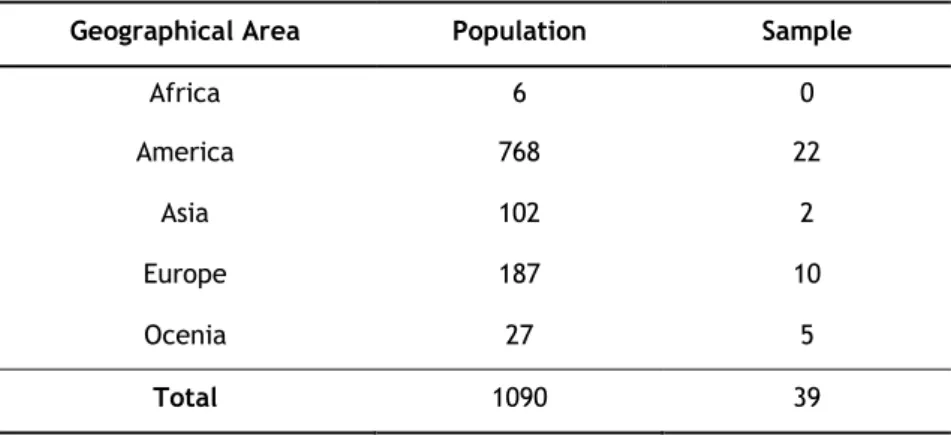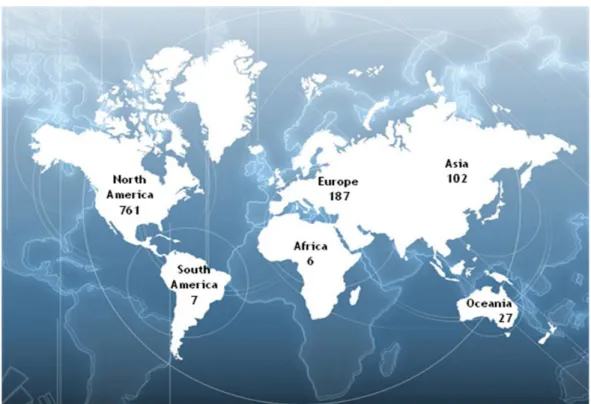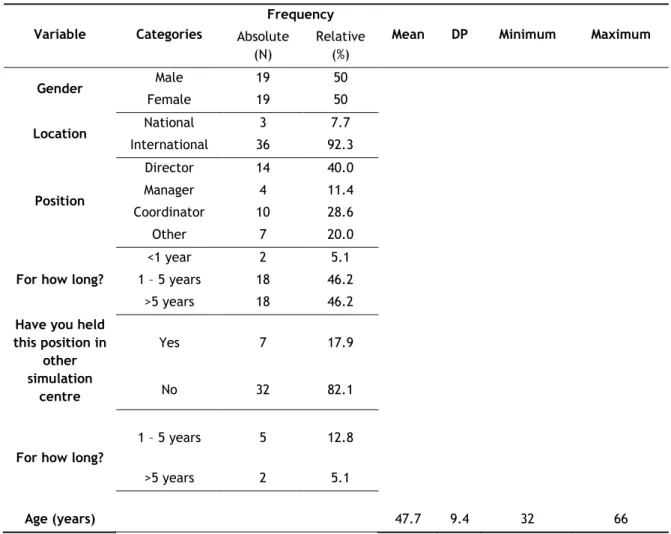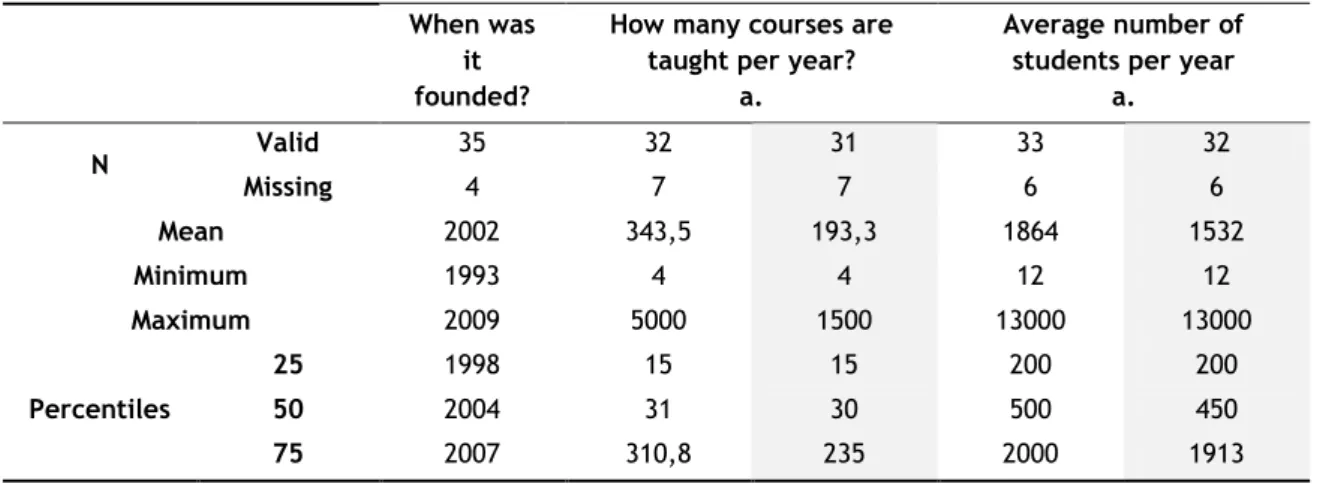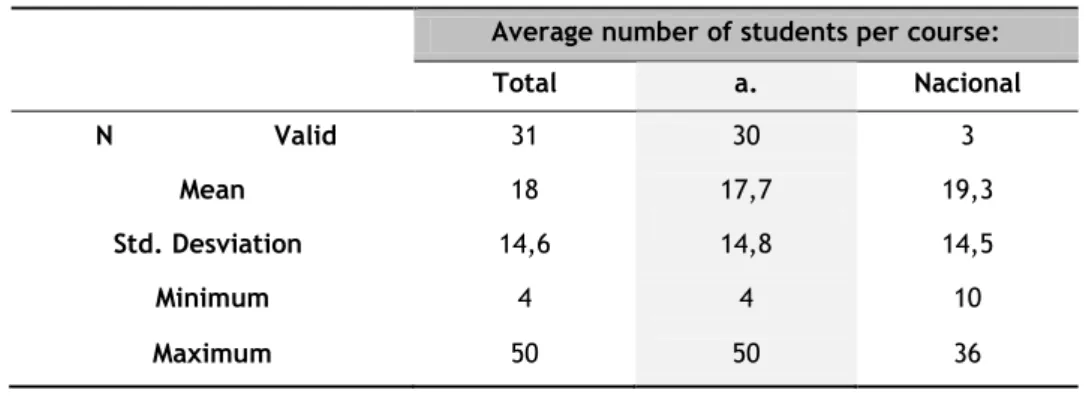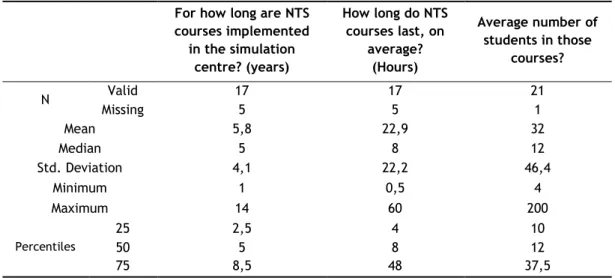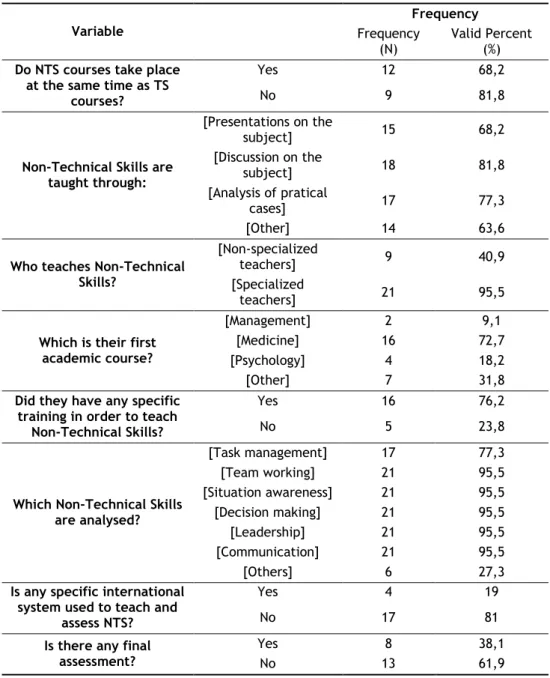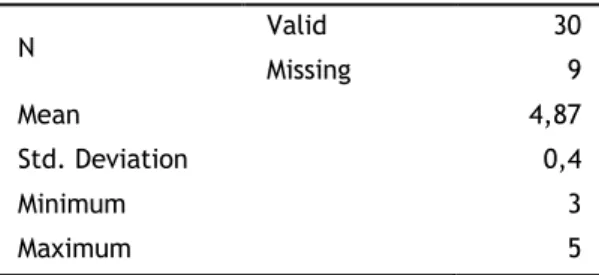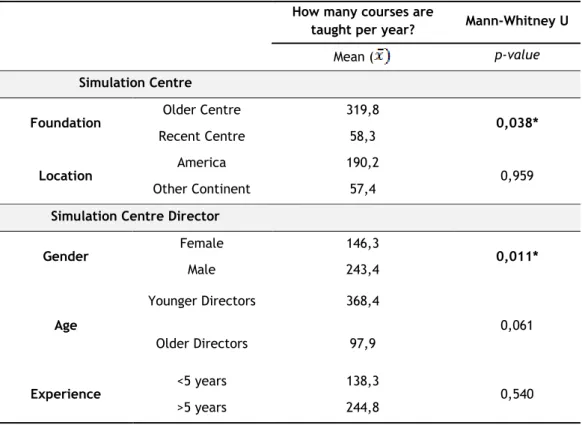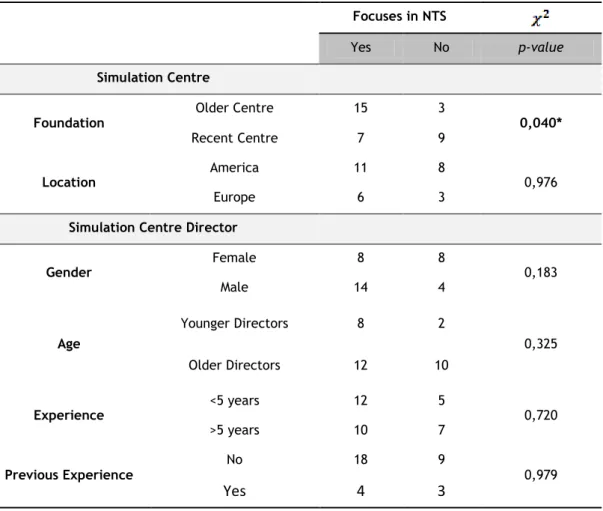Ciências da Saúde
The Teaching of Non-Technical Skills through
Medical Simulation
Juliana Andreia da Costa e Silva
Dissertação para obtenção do Grau de Mestre em
Medicina
(Ciclo de estudos integrado)
Orientador: Professor Doutor Henrique Manuel Gil Martins
Co-orientador: Professor Doutor Miguel Castelo-Branco Craveiro de Sousa
iii
Uma noite eu tive um sonho… Sonhei que andava a passear na praia com o Senhor e, no céu, passavam cenas da minha vida. Após cada cena que passava, percebi que eram deixados dois pares de pegadas na areia; um era meu e o outro, do Senhor. Quando a última cena da minha vida passou diante de nós, olhei para trás, para as pegadas na areia,
e notei que muitas vezes, no caminho da minha vida, havia apenas um par de pegadas na areia.
Notei também que isso aconteceu nos momentos mais difíceis e angustiosos do meu viver. Isso entristeceu-me deveras, e perguntei, então, ao Senhor: "Senhor, Tu disseste-me que, uma vez que resolvi seguir-te,
tu caminharias sempre comigo, mais notei que, durante as maiores tribulações do meu viver, havia apenas um par de pegadas na areia.
Não compreendo, porque é que, nas horas em que mais precisei de ti, tu me deixaste sozinho". O Senhor respondeu-me: "Meu precioso filho, jamais te deixaria nas horas de prova e sofrimento. Quando viste, na areia, apenas um par de pegadas, eram as minhas. Foi exactamente aí que eu peguei em ti ao colo".
v
Dedicatória
À minha família. Ao Tomás. À minha querida Ana Luísa.
vii
Agradecimentos
Mais do que um trabalho individual, esta dissertação é o resultado da colaboração e contributo de várias pessoas num processo que foi tudo menos solitário. Por esta razão quero expressar os meus sinceros agradecimentos:
À Faculdade de Ciências da Saúde e à Universidade da Beira Interior por me permitirem aprender aqui a ser o que sempre quis ser, para o resto da minha vida.
Ao Professor Doutor Miguel Castelo-Branco, presidente da Faculdade, meu co-orientador e exemplo de trabalho e capacidade de organização para mim, obrigada pela sua disponibilidade; e ao Professor Doutor Taborda Barata, coordenador do 6º ano, obrigada pela valiosa orientação que nos deu na recta final deste longo percurso.
Um agradecimento especial ao meu orientador, o Professor Doutor Henrique Martins, por se ter disponibilizado desde a primeira hora a orientar a minha tese, e por todo o tempo que dispôs para me ajudar na concretização da mesma.
À Dr.ª Rosa Saraiva, responsável pelo Núcleo de Investigação do Centro Hospitalar Cova da Beira, pela disponibilização de vários artigos científicos e pela orientação em relação aos aspectos burocráticos relacionados com a elaboração desta Tese.
Aos serviços informáticos da Faculdade de Ciências da Saúde, especialmente à Andrêa Mendonça, ao Pedro Sousa e ao Adriano Raposo, por se terem disponibilizado sempre para me ajudarem, dado o meu parco conhecimento na área que eles tão bem dominam.
À Dr.ª Marisa Navio, pelos conhecimentos que me transmitiu, e pela paciência com que sempre esclareceu as minhas dúvidas.
A todos os directores/coordenadores das instituições que fazem parte de estudo, e que disponibilizaram o seu tempo para me responder, tornando este projecto uma realidade. O meu muito obrigado.
Aos meus queridos pais e irmão, pelo carinho com que sempre me ouviram, nas minhas pequenas vitórias e nos momentos difíceis de construção deste projecto, por nunca me terem faltado, e pelo apoio incondicional, apesar da grande distância que nos separa na maior parte dos dias, admiro-vos muito, e espero ser merecedora do vosso amor.
viii
À minha avó Maria, por ser um grande exemplo de vida para mim, pela coragem que sempre teve durante toda a sua vida apesar das adversidades e que me ensinou a ter também, pela sua alegria de viver, pela sua generosidade para com os outros e por tudo que me ensinou, por ser minha mãe, o meu muito obrigado.
Ao meu avô Manuel, pela sua boa disposição, pelos conselhos, por me receber sempre com os braços abertos quando volto para casa, por perguntar sempre como estão as coisas e esperar sempre pela resposta.
Às minhas ―irmãs do coração‖, a Dulce, a Cláudia, a Joana Manuela, a Joana Daniela a Ana Isabel e a Vânia, por ouvirem, sem contestar, as minhas dúvidas, angústias e lamentações, tantas vezes durante a elaboração desta Tese.
A todos os meus amigos e colegas na Covilhã, esta cidade que tão bem me acolheu, especialmente à Ana, à Rita, à Martinha, à Marina, à Mónica, ao Miguel e ao Marco, pela amizade, pelo apoio durante esta difícil fase final e por todos os momentos espectaculares que vivemos juntos durante estes seis anos e que guardarei para sempre na minha memória e no meu coração.
À Rita e à Sara, minhas companheiras neste caminho desde o início, agradeço-vos acima de tudo, terem caminhado comigo, terem estado presentes neste meu percurso em todos os bons e maus momentos. Agradeço-vos a paciência, o apoio e a vossa amizade sincera.
Um agradecimento muito sincero e sentido à minha grande companheira na elaboração deste projecto, à pessoa que mais sacrificou o seu precioso tempo para me ajudar, à pessoa que nunca teve um não para dizer a todos os meus pedidos de colaboração, à pessoa que fossem que horas fossem esclarecia sempre as minhas dúvidas, à pessoa que tinha sempre uma opinião assertiva para dar perante a minha insegurança, à pessoa sem a qual esta Tese não teria a qualidade linguística que se espera ter, à minha prima e grande amiga, à minha querida Ana Luísa. Muito obrigada. Nunca te vou poder agradecer de facto o que fizeste por mim nesta jornada.
E por fim, mas não menos importante, ao Tomás. Obrigada por estares ao meu lado todos os dias da minha vida. És a minha alegria, a minha força. Representas o que de melhor e mais importante há na vida para mim.
ix
Resumo Alargado
Introdução: No sentido de corresponder às expectativas da sociedade, de que os médicos
"podem e vão atender igualmente a todos os aspectos dos cuidados de saúde", a Associação Americana dos Colégios Médicos, através do projecto ‖Objectivos da Escola Médica - Relatório I‖ postulou que os médicos devem ser altruístas, inteligentes, dotados de habilidades/competências, e atenciosos. Este aprimoramento não será de todo fácil, mas é óbvio para todos que devem ser operadas mudanças na prática médica para que esta se torne cada vez mais uniforme e segura para o doente. Com os olhos postos em outras áreas profissionais, nomeadamente a aviação, tem-se constatado que a minucia exigida no desempenho de variadas funções nessa área, assim como a necessidade de rápida tomada de decisão, se assemelha largamente à capacidade prática de desempenho/competências exigidas aos médicos no exercício, por exemplo, de procedimentos cirúrgicos, ou simplesmente na tomada de decisão correcta e atempadamente em situações de perigo iminente para a vida do doente, ou, no caso da área supramencionada, da tripulação. Considerando essas competências como acções e reacções realizadas por um indivíduo de uma forma competente, a fim de atingir uma meta, não há dúvida de que essa meta será tão melhor conseguida, quanto maior for a experiência e as habilidades práticas do seu executante. Com base nessa declaração, a capacidade de recriar situações reais, proporcionada pela simulação, permite, hoje em dia, adquirir experiência e ao mesmo tempo possibilita o desenvolvimento de determinadas competências e habilidades práticas, essenciais ao médico no exercício da sua profissão. A simulação tem-se revelado, assim, uma mais-valia para a prática médica, sendo cada vez maior a eficácia e fiabilidade da aprendizagem realizada desta forma. No entanto, e sendo óbvio que os procedimentos clínicos requerem competências técnicas, o treino de habilidades, através da simulação, tem-se focado, quatem-se exclusivamente, no treino da componente técnica/prática, ignorando outras competências-chave, não técnicas, como a capacidade de comunicação, de tomada de decisão e o profissionalismo. Apesar de ainda poucos estudos terem sido realizados no âmbito destas competências não técnicas, estes reivindicam a necessidade emergente de sua valorização e aplicação no ensino médico, juntamente com o ensino de competências técnicas, em falta, actualmente, na maioria dos casos e instituições de ensino.
Objectivo: O objectivo principal deste estudo é entender melhor qual a importância atribuída
ao ensino da competências não técnicas, a par do ensino de competências técnicas, e a que nível se encontra actualmente a implementação do ensino de tais habilidades através da simulação, nos centros de simulação médica de todo o mundo.
x
Métodos: Este foi um estudo exploratório. O modelo de pesquisa utilizado foi o descritivo e
correlacional (ou seja, centrado na descrição e caracterização das variáveis envolvidas); 1090 Centros de Simulação em todo o mundo foram aleatoriamente mapeados através de pesquisa manual na Internet. Destes, 39 responderam a um questionário online, enviado por correio electrónico, constituindo estes respondentes a amostra final.
Resultados: 1090 Centros Simulação em todo o mundo foram mapeados e foi criada uma lista
de contactos dos mesmos. Dos 39 centros que responderam, a parcela mais representativa foi dos Estados Unidos da América (n=22). Cerca de 50% dos centros participantes foram fundados depois de 2004 e cerca de 25% depois de 2007. Em média, as instituições inquiridas ensinam 193 cursos por ano, a uma média de 1532 alunos. Do total de participantes no estudo, 64,7% (n=22) afirmaram ter um curso direccionado especificamente para o ensino de competências não técnicas, e doze negaram-no (36,1%). Os resultados mostram também que a antiguidade da instituição, e género do seu director parecem relacionar-se com a maior oferta de formação das instituições (p=0,038 e p=0,011<0,05, respectivamente). Portanto, instituições com mais anos de existência e dirigidas por homens possuem, em média, um volume maior de oferta formativa. Também se pôde concluir que existe uma relação estatisticamente significativa, com valor-p<0,05, entre a antiguidade da instituição e o enfoque diferenciado no ensino de competências não técnicas dado por esta, ficando explícito que centros de simulação mais antigos têm, em média, cursos direccionados especificamente para o ensino de competências não técnicas.
Conclusão: Actualmente, e sendo o ensino de competências não técnicas um fenómeno
relativamente recente e ainda em crescimento, o nível de implementação deste ensino nos centros de simulação médica está ainda aquém das expectativas, apesar da importância que lhe é atribuída e reconhecida. Pôde-se também constatar, pela distribuição encontrada, que muitos centros de simulação existem em todo o mundo, especialmente nos Estados Unidos da América, mas cada vez mais na Europa e também em países Asiáticos. Finalmente, pela análise dos resultados pode-se concluir que existe uma forte relação entre três variáveis, a antiguidade das instituições, a oferta de formação das mesmas e a existência de um enfoque diferenciado no ensino de competências não técnicas, sendo que, instituições mais antigas e com maior volume de cursos a serem leccionados, normalmente também comtemplam cursos direccionados especificamente para o ensino de competências não técnicas.
xi
Palavras-chave
xiii
Abstract
Introduction: To meet society‘s expectations that physicians ―can and will attend equally to
all aspects of health care,‖ the Association of American Medical Colleges‘ Medical School Objectives Project Report I has stated that physicians must be altruistic, knowledgeable, skillful, and dutiful. Considering that skills may be defined as actions and reactions performed by an individual in a competent way in order to achieve a goal, there is no doubt that this goal will be better managed the greater the expertise and practical skills of its performer. Based on this statement, the recreation of real situations to improve practical skills, allows the benefits of learning through simulation to become increasingly effective and reliable. It is obvious that clinical procedures require technical skills. Skills‘ training using simulation has, for the most part, focused on technical expertise, ignoring other key competencies such as professionalism and communication skills. Despite studies on non-technical skills (NTS) claiming the emerging need of their valuation and implementation in medical education alongside technical skills (TS), in most instances and institutions such education is lacking.
Objective: The main purpose of this study is better understand the importance attributed to
teaching of NTS alongside TS, and the implementation of such skills teaching through medical simulation in medical simulation centres around the world.
Methods: This was an exploratory study. The research model used was descriptive and
correlational (i.e. centred on the description and characterization of variables involved); 1090 Simulation Centres worldwide were randomly mapped by manual search via Internet. Of these, 39 answered an online questionnaire.
Results: 1090 Simulation Centres worldwide were mapped and a contact list was created. Of
the 39 centres that responded, most were from the United States of America (n=22). About half of the total participating centres were founded after 2004 and about a quarter after 2007. The surveyed institutions teach on average around 193 courses per year to an average number of 1532 students. Of all participants in the study, 64.7% of them (n=22) said they had a course with special focus on NTS, and twelve declined (36.1%). Results also show that centre‘s antiquity appear to relate with the amount of courses supplied by these centres (p=0.038 and p=0.011<0.05, respectively). Besides, it is also possible to conclude that there is a differentiated focus on the teaching of NTS according to the Simulation Centres‘ antiquity (p<0.05), which proves that in older simulation centres there is a greater differentiated focus on the teaching of NTS.Conclusion: Nowadays, being the teaching of NTS a recent but growing phenomenon, the level of implementation of NTS is still far from meeting expectations, and the importance attributed. It may also be noted, by distribution found,
xiv
that many simulation centers exist worldwide especially in the United States, but increasingly in Europe and Asian nations. Moreover, one may conclude that there is a strong relationship between the antiquity of the institutions, the training supply of the centres and the existence of a differentiated focus on the teaching of NTS. The oldest institutions, with greater volume of courses to be taught, are usually also the ones who contemplate courses geared specifically to teaching non-technical skills.
Keywords
xv
Index
Dedicatória ... v Agradecimentos ... vii Resumo Alargado ... ix Abstract... xiiiIndex of Figures ... xvii
Index of Tables ... xix
Index of Graphs ... xxi
Index of Acronyms ... xxiii
1. Introduction ... 1
2. Objectives ... 5
3. Methods ... 7
3.1. Type of study ... 7
3.2. Maping of simulation centres ... 7
3.3. Data collection ... 8
3.4. Procedures ... 9
3.5. Description of variables ... 9
3.6. Statistical analysis ... 11
4. Results ... 13
4.1. Map of biomedical simulation centres ... 13
4.2. Characterization of the participating simulation centres ... 14
4.3. The teaching of technical and non-technical skills at the participating simulation centres ... 20
4.4. Differentiated focus on the teaching of NTS ... 25
5. Discussion ... 29
6. Conclusion ... 39
7. References ... 41
8. Annexes ... 45
8.1. Annex I – Questionnaire: Teaching Non-Technical Skills through Medical Simulation .. 45
8.2. Annex II - Lists with contact information from all simulation centres mentioned in the study ... 51
xvii
Index of Figures
xix
Index of Tables
Table 1. Population and sample per continent ... 7
Table 2: Profile of the simulation centres‘ representatives under consideration ... 14
Table 3. Characteristics of the simulation centres under consideration ... 16
Table 4. Average number of students per course in the simulation centres ... 19
Table 5. Focus on the teaching of NTS integrated in TS courses ... 21
Table 6. NTS courses implemented at simulation centres... 22
Table 7. Teaching and assessment of nts courses ... 23
Table 8. General importance given to the teaching of NTS ... 24
Table 9. Differentiated training supply of the simulation centre ... 25
xxi
Index of Graphs
Graph 1. Distribution of the location of simulation centres per country ... 15
Graph 2. Distribution of the location of simulation centres per continent ... 15
Graph 3. Boxplots of the number of courses taught per year in simulation centres and the average number of students per year ... 17
Graph 4. Simulation centres‘ supply ... 18
Graph 5. Courses duration ... 18
Graph 6. Distribution of courses according to target students ... 19
Graph 7. Existence of courses with focus on non-technical skills ... 20
xxiii
Index of Acronyms
NTS Non-Technical Skills TS Technical SkillsSBME Simulation Based Medical Education SPSS Statistical Package for Social Sciences BCLS Basic Cardiac Life Support
ACLS Advanced Cardiac Life Support ALTS Advanced Trauma Life Support
EAMC Emergency Airway Management Course FCCS Fundamental Critical Care Support ACCS Acute Care Common Stem
CRM Crisis Resource Management CCE Critical Cardiac Events AILS Adult Immediate Life Support PBLS Paediatric Basic Life Support PALS Paediatric Advanced Life Support UN United Nations
HDI Human Development Index GDP Gross Domestic Product
1
1. Introduction
To meet society‘s expectations that physicians ―can and will attend equally to all aspects of health care,‖ the Association of American Medical Colleges‘ Medical School Objectives Project Report I(1) has stated that physicians must be altruistic, knowledgeable, skilful, and dutiful.
According to Maudsley, prescribing such undergraduate outcomes is much easier than achieving them.(2)
Thus, this improvement will not be easy at all, even though it is obvious to the health professionals class that today changes have to be operated in medical practice so that the above statement is reached, making the medical practice more uniform and safer for the patient.The philanthropic qualities of a physician have become insufficient to society in general for some time. This professional must have vast knowledge and, as the Association of American Medical Colleges now reports, also skills, abilities and expertise in carrying out all the acts related to the medical profession.
Firstly, we must consider what we are talking about when referring to skills. ―Skills may be defined as actions and reactions performed by an individual in a competent way in order to achieve a goal.‖(3)
There is no doubt that this goal, in this particular case any medical procedure, will be better managed the greater the expertise and practical skills of its performer. Expertise will depend on many factors, various with which we cannot interfere, such as the intellectual capacity of each professional; still, the practical ability to perform, for example, a surgical procedure or simply to learn how to react properly in a timely manner to a situation of danger to the patient‘s life, such as a shock, or cardiac arrest, can and should be practiced. This is the basic / elementary principle of simulation in the learning of medical practice.
Making it looks like real situations or procedures, that are not in the moment, allows us to develop key/essential skills a physician must have in real similar situations.However, the transformation of the individual action process to the medical team work should not be overlooked in these contexts, since it is indispensable to the effective achievement of the abovementioned objective.From this point of view, in medicine, and particularly in extreme situations, we must realize that teamwork is imperative to overcome personal shortcomings, and that a multidisciplinary approach is undoubtedly becoming more essential.In recent decades, the transformation of work made the team the "foundation stone" to many organizations, believing that it would be irrefutable. This is because, by grouping together
2
various skills and expertise one reaches greater efficiency and better coordination. Teamwork improves the quality of patient care.(4-6)
Nowadays, medical teams depend on technical skills (TS) as well as non-technical skills (NTS) for the successful management.(7) ―Rapid response teams are quickly becoming an important
patient safety strategy in the prevention of death in patients who are progressively failing outside of intensive care units.‖(8)
Technical skills can be perceived as knowledge and proficiencies required in the performance of engineering, scientific, or any specific task. In medicine, we refer to operating modes in specific health care situations and we have as an example the guidelines of procedures. ―Non-technical skills are behavioural principles related to leadership, task distribution, teamwork and communication.‖(9) Skills like leadership, teamwork, negotiation, situation
awareness and interpersonal exchange are crucial to achieve the best possible results during critical situations and must also be learned in medicine.(7)
Given these concepts, there was a need to integrate them properly in medical education. Accordingly, in the past three decades, there have been significant changes in medical education, being technology a major factor in this change. ―Technology is playing an increasingly important role in skills training, which is related to the ―skilful‖ attribute listed in the Medical School Objectives Project Report.‖(10)
That technology applied in recreating real situations allows the benefits of learning through simulation to become increasingly effective and reliable.
Even though simulation technology, including multimedia computer programs, is well established in other disciplines, such technology is only now gaining wider acceptance in medicine.(10) Other examples include ―the use of flight simulators for pilots and astronauts, (11-13) war games and training exercises for military personnel,(14) management games for business
executives,(15, 16) and technical operations for nuclear power plant personnel.(17)‖(10)
Just to clarify, simulations are not identical to ―real life‖ events. Instead, simulations place trainees in life-like situations that provide immediate feedback about questions, decisions, and actions.(10)
Medical professionals and educators recognize that Simulation Based Medical Education (SBME) can considerably contribute to the improvement of medical care by boosting medical
3
professionals‘ performance and enhancing patient safety. ―A central characteristic of SBME is its unique approach to making (and learning from) mistakes, which is regarded as a powerful educational experience and as an opportunity for professional improvement.(18)
The basic assumption underlying SBME is that increased practice will reduce occurrences of errors in real life and provide professionals with the correct attitude and skills. This assumption should also serve as a starting point for critical thinking and questioning regarding the multiple aspects and components of SBME.‖(18)
Can technical and non-technical skills be taught through medical simulation? Few studies regarding NTS have been developed in this area. The few studies on NTS highlight the emerging need of their valuation and implementation in medical education alongside TS.(7-9)
Despite the fact that clinical procedures obviously require the integration of both technical and communication skills, skills‘ training through simulation has exclusively focused on technical expertise, ignoring other key competencies such as professionalism and communication skills, in most of the situations and institutions. ―Technical performance will not be impaired by focus on NTS as well.‖(19)
For this reason, this study aims to contribute to a better understanding of the level of importance that is currently given to the teaching of the NTS alongside TS through medical simulation, by specifically analyzing how particular parameters, like the number of courses provided by the institutions, and, subsequently, the focus on the differentiated teaching of NTS, relate to or are dependent on some variable, such as the antiquity of the institution concerned, the location of the same worldwide, or vary depending on the characteristics of the simulation centre director, including age, gender, years of experience in the institution, or previous experience in other similar institutions.
5
2. Objectives
The present study aims to contribute to a better understanding of the level of importance given to the teaching of non-technical skills (NTS), together with the technical skills (TS) in different simulation centres, both national and international, analyzing the simulation centres‘ characteristics and the type of leadership of their representatives. The specific objectives (SO) are as follows:
SO1: To create a map showing the distribution of biomedical Simulation Centres on the world, attaching a list of simulation centres and respective contact information;
SO2: To describe the sample of representatives questioned on individual characteristics and professional experience in the performance of leadership positions in the respective simulation centres;
SO3: To get to know the simulation centres involved in this study, concerning training supply, teaching and assessment methods in the teaching of non-technical skills (NTS) and technical skills (TS);
SO4: To relate the location, antiquity and management of the simulation centres with the importance or focus given to the teaching of non-technical skills (NTS).
7
3. Methods
3.1. Type of study
As this is an exploratory study, the research model used was the descriptive and correlational, i.e. centred on the description and characterization of variables involved in the study and on the understanding and prediction of phenomena by formulating hypotheses about the relationships between variables.(20) These hypotheses were only presented when
there was a significant relationship.
3.2. Maping of simulation centres
The population of the study includes 1090 international simulation centres randomly found on the internet, which were subsequently contacted by email. Contact was made with 6 simulation centres in Africa, 187 in Europe, 27 in Oceania, 102 in Asia and 768 in America (761 in North America and 7 in South America).
Table 1: Population and sample per continent
Geographical Area Population Sample
Africa 6 0 America 768 22 Asia 102 2 Europe 187 10 Ocenia 27 5 Total 1090 39
8
3.3. Data collection
The data collection was performed by means of a questionnaire comprising questions about how the teaching of non-technical skills (NTS) is integrated in the teaching of technical skills (TS) through medical simulation. This questionnaire was accessible online via the application
Lime Survey for web from 1 October 2010 to 28 February 2011.
The questionnaire consists of six parts. (Annex I)
The first part allows the characterization of the respondent concerning age, gender, position hold at the simulation centre and for how long. It also contains the simulation centre identification and its location.
The second aims to collect information such as year of foundation, number of courses taught per year, average number of students per year and course, the training supply of the simulation centre and duration of the courses provided and to which academic level are the courses intended.
The third part of the questionnaire focuses on the teaching of skills. The respondent is asked about how the simulation centre includes the teaching of non-technical skills in technical skills courses. In particular, what is the basic academic level and/or specialization of the professionals responsible for these courses, as well as the type of non-technical skills analyzed and how the assessment is carried out.
In the fourth part there are questions related to the teaching of non-technical skills at the simulation centre. The respondent should say if these courses are implemented, how many times per year do they take place, its average duration, average number of students attending, teaching methods, who are the teachers, what is their basic academic level and specialization, which NTS are analyzed, if there is any specific international system in the teaching and assessment of NTS and how is the final assessment carried out.
The fifth part of the questionnaire touches on the importance of NTS and the last part on the importance given to leadership.
There are open and closed questions in the questionnaire. Some of the closed questions are multiple choice questions, others are mutually exclusive.
9
3.4. Procedures
The request for cooperation addressed to simulation centres for this research was made via email. The message sent included the identification of the author, a brief summary of the research project concerned and the link to access the questionnaire online.
This message also specified to whom the questionnaire was addressed, as it contains questions which could only be answered by professionals occupying senior positions in the institution and with access to specific information.
During the five-month period, in which the questionnaire was available online, the simulation centres were contacted three times.
The IT platform Lime Survey provided by the Faculty of Health Sciences, to which this research project is intrinsically linked, served as the support for the database containing the answers to the questionnaire.
These data were afterwards exported to a SPSS file to enable their processing and statistical analysis.
Besides, data confidentiality was guaranteed during the processing and the analysis of the results.
3.5. Description of variables
Variables are characteristics measured, controlled and manipulable.(21) They differ in many
aspects, particularly in the role they are given and the way they can be measured.
According to the characteristic one intends to measure, the variables in the study are divided into three different groups:
Characteristics of the simulation centre representative: age, gender, position hold and for how long, previous professional experience on the same position in other Centres and respective duration.
Characteristics of the simulation centres: location of the centres (country or continent), year of foundation, number of courses per year, average number of students per year, type of training supply and duration, average number of students
10
per course and training recipients. For centres with implemented NTS courses: time of existence of NTS courses, number of times they take place per year, average duration of the courses and average number of students per course.
Teaching of Non-Technical Skills: specific focus on the teaching of NTS, the integrated teaching of NTS in TS courses, teaching method used, basic academic level and specialization of NTS teachers, types of NTS analyzed in the courses, final assessment in the NTS courses and the level of importance given to the teaching of NTS.
The choice for the appropriate statistical processing makes it necessary to identify the measure scales or levels for each variable under consideration. There are four measure scales or levels for variables: nominal, ordinal, interval and ratio. The first three were the ones used in this study. Pestana and Gageiro (22) give a definition for each type of scale:
Nominal scales are the ones in which numbers are used to name, identify and categorize data. The following variables are examples of this type of scale: gender, position hold, previous experience in the same position in other centres, centres location, type of training supply, training recipients, specific focus on the teaching of NTS, implemented teaching of NTS in TS courses, teaching method used for NTS, basic academic level and specialization of NTS teachers, type of NTS analyzed on courses, final assessment of NTS courses.
In an ordinal scale only different levels of an attribute or variable can be distinguished. In between these levels there is an order relationship, not quantifiable. The period working in the position hold and the duration of courses are examples of variables under consideration measured in this type of scale. Likert scales are also examples of ordinal scales. In this study the variable showing the level of importance given to NTS teaching belongs to this type.
In interval scales, variables take quantitative values and allow comparison of differences between measurements. Age, year of foundation, number of courses per year, average number of students per year, average number of students per course, time of existence of NTS courses, number of times these courses take place per year, average duration of NTS courses and average number of students per NTS course. By and large, data showing merely nominal and ordinal properties are classified as non-metric data or qualitative variables. Conversely, data with interval or ratio properties are considered metric data or quantitative variable.
11
3.6. Statistical analysis
The procedure for the statistical analysis used in this study is summarized in two aspects: sample characterization of simulation centres and their representatives based on descriptive statistics and inferential analysis for the validation of the hypotheses under consideration. The descriptive study of the variables includes the appropriate statistics for data interpretation, their graphic representation and for the identification of non-standard observations or outliers. (22) Therefore, on the one hand, absolute and relative frequencies
were used to describe qualitative, nominal and ordinal variables. To describe quantitative variables, on the other, measures of central tendency, such as mean and quartiles, and measures of dispersion, standard deviation and range of variation were used. It was also used a graphic illustration of the results by means of circular and bar graphs for qualitative variables. For quantitative variables, boxplot diagrams were used instead. The presence of outliers was studied in order to analyze the influence of extreme cases on the mean value. It was nevertheless decided to keep those cases, as they are part of the phenomenon being studied.
After characterizing the sample of the simulation centres and their representatives, the decisions were reasoned using hypotheses tests. In these tests, the hypotheses to be tested are formulated and the test statistics and corresponding probability of significance are calculated (p-value). Based on the latter, one can figure out if there is statistical evidence to reject the null hypothesis (H0) or not. The 0.05 value (i.e., 5%) serves as significance level (α) to determine if something is statistically significant. Other significance levels used are 0.1 e 0.01. The statistical software calculates the p-value. If p-value α, then H0 would be rejected.
The Qui-square test was performed to test the independence of qualitative variables. In cases where this test could not be applied with precision, the qui-square test using Monte Carlo Simulation method was performed. Note that the qui-square can only be applied under three conditions: n>20; all expected values above 1; and at least 80% of the values equal or above 5.
The Mann-Whitney test was used as a non-parametric alternative to test T to compare means of quantitative variables among analysis-independent groups.
12
In the analysis only valid cases were taken into consideration. All the statistical procedure was performed using the SPSS software (Statistical Package for the Social Sciences), version 19.0. MS Excel 2007 was also used to draw some graphs.
13
4. Results
4.1. Map of biomedical simulation centres
1090 Simulation Centres worldwide were randomly mapped by research on the Internet. Contact was made with 6 simulation centres in Africa, 187 in Europe, 27 in Oceania, 102 in Asia and 768 in America (761 in North America and 7 in South America).
The list containing contact information from all simulation centres mentioned in this study is attached to this document. (Annex II)
From the 1090 simulation centres contacted by email, 39 have answered the questionnaire. Those were located in four different continents: 22 in America, 2 in Asia, 10 in Europe and 5 in Oceania. There was no representation from the African continent (n=39).
14
4.2.Characterization of the participating simulation centres
Table 2 shows a summary of the descriptive characteristics‘ results associated with the profile of the simulation centres‘ representatives. 39 simulation centres‘ representatives (7.7% national and 92.3% international) have answered the questionnaire, half of them were men and the other half women. The age of the respondents ranged from 32 to 66 years old. The mean age was approximately 48 years old, with an associated standard deviation of around 9 years. The great majority of the asked representatives are directors (40%) or coordinators (28.6%). In most cases (92.4%), they hold that position for over a year and 46.2% for more than 5 years or for a period of 1 to 5 years. Only 7 respondents have held such position in other Simulation Centre. Of those, 5 have acted as director or coordinator for a period of 1 to 5 years and 2 of them for a period over 5 years.
Table 2: Profile of the simulation centres‘ representatives under consideration
Variable Categories
Frequency
Mean DP Minimum Maximum
Absolute (N) Relative (%) Gender Male 19 50 Female 19 50 Location National 3 7.7 International 36 92.3 Position Director 14 40.0 Manager 4 11.4 Coordinator 10 28.6 Other 7 20.0
For how long?
<1 year 2 5.1
1 – 5 years 18 46.2
>5 years 18 46.2
Have you held this position in other simulation centre Yes 7 17.9 No 32 82.1
For how long?
1 – 5 years 5 12.8
>5 years 2 5.1
15
The study participating simulation centres are mainly located in the United States (48.7%). Graph 1 shows the distribution of all centres‘ location around different countries. In Portugal, three simulation centres have answered the questionnaire, which corresponds to 7.7% of the total number of centres in this study.
Graph 1: Distribution of the location of simulation centres per country.
16
Graph 2 makes it also possible to analyse the distribution of simulation centres per continent. There is a greater concentration of simulation centres participating in this study located on the American (56.4%) and European (25.6%) continents and there is no representation from the African country.
Table 3 presents the descriptive statistics that allow the characterization of the simulation centres concerning year of foundation, number of courses taught per year and average number of students per year.
Table 3: Characteristics of the simulation centres under consideration
a. Outlier case 34 has been removed.
Analysing these aspects, one can observe that the participating simulation centres were founded between 1993 and 2009, 50% of which were founded after 2004 and 25% between 2007 and 2009.
It is important to highlight that the frequency of courses is quite distinct in different simulation centres. It is therefore necessary to analyse the influence of extreme observations on the average value.
As can be observed in the boxplot graph (graph 3), there are outliers in both variables. The case number 34 is identified as an outlier in both variables, that is, the simulation centre from Singapore, which has 5,000 courses per year and an average of 12,500 per year, is considered an atypical case influencing the average value found. Moreover, the interquartile range and the variation interval for these two variables show a great variability of the data around the average. As a matter of fact, the values 296 and 4,996, respectively, for the distribution of the number of courses per year and values 1800 e 12,988, respectively, for the distribution of the average number of students per year were registered.
When was it founded?
How many courses are taught per year?
a.
Average number of students per year
a. N Valid 35 32 31 33 32 Missing 4 7 7 6 6 Mean 2002 343,5 193,3 1864 1532 Minimum 1993 4 4 12 12 Maximum 2009 5000 1500 13000 13000 Percentiles 25 1998 15 15 200 200 50 2004 31 30 500 450 75 2007 310,8 235 2000 1913
17
Removing from analysis the case number 34 and recalculating the value of descriptive statistics (table 3, paragraph a.) it appears that, an average of 193 courses per year are taught to an average number of 1532 students.
The joint analysis of Table and Graph 3 makes it possible to ascertain that 50% of Simulation Centres have less than 30 courses per year and an average number of 450 students.
In particular, the national simulation centres were founded between 2003 and 2008 and have an average number of 33 courses and of 533 students per year.
Graph 3: Boxplots of the number of courses taught per year in simulation centres and the average number of students per year
With reference to the training supply of the 39 medical simulation centres, it can be observed in graph 4 that the courses BCLS (53.8%), ACLS (48.7%) and EAMC (23.1%) are the most common. On the contrary, the courses FCCS (12.8%) and ACCS (10.3%) are the ones with lower supply percentages among the six courses mentioned. Analysing, in particular, the supply of the national simulation centres, it can be noticed that only BCLS, ACLS and EAMC courses are taught. These simulation centres‘ representatives highlight other courses included in their supply: Crisis Resource Management (CRM), Critical Cardiac Events (CCE), Obstetric Emergencies, Neonatal Resuscitation, Adult Immediate Life Support (AILS), Paediatric Basic Life Support (PBLS), Paediatric Advanced Life Support (PALS), lessons on Medical-Surgical Nursing and Emergency Nursing.
18
The duration of these courses also varies from one simulation centre to another (graph 5). From the 39 simulation centres in this study, 27 have reported that have courses being taught during all year. The remaining Centres have short-term courses: per season (7), per semester (3) or short sessions from 2 to 3 days or some hours (5).
Graph 4: Simulation centres’ supply
19
By analyzing table 4, it is further observed that courses have an average of 18 students. The minimum average number of students registered per course was 4 and the maximum was 50. The courses taught in national simulation centres register an average number of around 19 students per course, even though some of them were taught for a minimum of 10 students and a maximum of 36.
Table 4: Average number of students per course in the simulation centres
a. Retirando o caso 34
Graph 6: Distribution of courses according to target students
Graph 6 shows the target academic level of the courses taught at the medical simulation centres under consideration. The target of the great majority of courses is graduates in Nursing (61.5%), Medicine (56.4%) and other professionals with more than 10 years of experience (51.3%).
Average number of students per course: Total a. Nacional N Valid 31 30 3 Mean 18 17,7 19,3 Std. Desviation 14,6 14,8 14,5 Minimum 4 4 10 Maximum 50 50 36
20
4.3. The teaching of technical and non-technical skills at the
participating simulation centres
With reference to the simulation centres‘ supply, the participants were asked about the existence of any course with special focus on non-technical skills (NTS). 64.7% of the centres (n=22) answered in the affirmative and 35.3% (n=12) in the negative. In Portugal, 2 of the 3 participating centres have NTS focused courses.
Graph 7: Existence of courses with focus on non-technical skills.
On the one hand, from the 12 respondents who have answered that there was no focus on NTS in the courses taught, 63.6% (n=7) say the teaching of these skills are included in technical skills (TS) courses and that these techniques are taught through performance analysis in particular cases, post-training discussion in a simulation environment (n=5) or through presentations on the subject (n=4). These non-technical skills integrated in technical skills courses are mostly done by technical skills teachers (n=6), even though some centres say they have specialized teachers (n=4). From the 7 respondents, 71.4% (n=5) also add that those teachers had a specific training in order to teach these non-technical skills. The non-technical skills analysed in these courses are diverse, having all highlighted teamwork, perception of the situation, decision-making, leadership and communication. Only 2 respondents have not mentioned tasks management. With reference to the assessment, 57.1% say there is no final assessment work but a practice-based assessment instead. Table 5 summarizes the information gathered on the teaching of NTS integrated in TS courses.
21 Table 5: Focus on the teaching of NTS integrated in TS courses
Variable Frequency Frequency (N) Valid Percent (%)
Is Non-Technical Skills teaching integrated in Technical-Skills
courses?
Yes 7 63,6
No 4 36,4
Non-Technical Skills are taught through: [Post-training discussion in a simulation environment] 5 71,4 [Presentations on the subject] 4 57,1 [Performance analysis in specific cases] 6 85,7 [Other] 3 42,9
Who teaches Non-Technical Skills?
[Technical-Skills teachers] 6 85,7
[Technical-Skills teachers] 4 57,1
Did they have any specific training in order to teach
Non-Technical Skills?
Yes 5 71,4
No 2 28,6
Which Non-Technical Skills are analysed? [Task management] 5 71,4 [Team working] 7 100 [Situation awareness] 7 100 [Decision making] 7 100 [Leadership] 7 100 [Communication] 7 100
Is there any final assessment? Yes 3 42,9
No 4 57,1
On the other hand, at the 22 simulation centres where there is any course with special focus on non-technical skills, the courses are already implemented for approximately 6 years, on average. The maximum number of years registered was 14 and the minimum 1. These courses last, on average, from 30 minutes to 2.5 days. The average number of students in these courses is 32. 4 students was the lowest average number registered per course, being the maximum 200 students.
22
Table 6: NTS courses implemented at simulation centres
For how long are NTS courses implemented in the simulation centre? (years) How long do NTS courses last, on average? (Hours) Average number of students in those courses? N Valid 17 17 21 Missing 5 5 1 Mean 5,8 22,9 32 Median 5 8 12 Std. Deviation 4,1 22,2 46,4 Minimum 1 0,5 4 Maximum 14 60 200 Percentiles 25 2,5 4 10 50 5 8 12 75 8,5 48 37,5
The number of times these courses take place over the year also varies, as shown in graph 8. In most simulation centres (n=15) these courses occur during all year and, in some cases, twice per year (n=4). It is also referenced the realization of these courses once per month, once per season and when requested.
Graph 8: Number of NTS courses.
Based on the results shown in Table 7, one can observe that in 68.2% of the simulation centres where the NTS courses are already implemented, NTS and TS courses take place simultaneously. With reference to the teaching method, the most commonly used are discussion on the subject (n=18), secondly, analysis of practical cases (n=17) and, finally, presentations on the subject (n=15). Simulation environments and interactive workshops are less frequently used for the teaching of these non-technical skills (n=14). These skills are
23
taught mainly by specialized teachers (95.5%). Their basic academic level differs. Most of them are teachers in the medical field (n=17), of Psychology (n=4) and of Nursing (n=3, from the total of 7 who have chosen the option ―other‖). 76.2% of these teachers have received specific training to teach NTS courses. The non-technical skills more frequently analyzed in these courses are teamwork, perception of the situation, decision-making, leadership and communication. Tasks management (n=17) and conflict resolution and professionalism (n=6, corresponding to the option ―other‖) are also analyzed but to a lesser extent. Regarding teaching and assessment, 81% of the respondents say there is no specific international assessment system and 62% say that there is no final assessment work.
Table 7: Teaching and assessment of nts courses
Variable Frequency Frequency (N) Valid Percent (%)
Do NTS courses take place at the same time as TS
courses?
Yes 12 68,2
No 9 81,8
Non-Technical Skills are taught through: [Presentations on the subject] 15 68,2 [Discussion on the subject] 18 81,8 [Analysis of pratical cases] 17 77,3 [Other] 14 63,6
Who teaches Non-Technical Skills?
[Non-specialized
teachers] 9 40,9
[Specialized
teachers] 21 95,5
Which is their first academic course?
[Management] 2 9,1
[Medicine] 16 72,7
[Psychology] 4 18,2
[Other] 7 31,8
Did they have any specific training in order to teach
Non-Technical Skills?
Yes 16 76,2
No 5 23,8
Which Non-Technical Skills are analysed? [Task management] 17 77,3 [Team working] 21 95,5 [Situation awareness] 21 95,5 [Decision making] 21 95,5 [Leadership] 21 95,5 [Communication] 21 95,5 [Others] 6 27,3
Is any specific international system used to teach and
assess NTS?
Yes 4 19
No 17 81
Is there any final assessment?
Yes 8 38,1
24
After questioning all representatives of the simulation centres concerning the importance of the teaching of NTS courses in their Institution (in an ascending scale of importance from 1 to 5), it could be observed that the average score obtained in this scale corresponded to 4.87, with a related standard deviation of 0.4 points. This means that all respondents considered the existence of these courses quite important. As a matter of fact, the minimum value registered in this scale was 3 points and the maximum 5 points.
Table 8: General importance given to the teaching of NTS.
N Valid 30 Missing 9 Mean 4,87 Std. Deviation 0,4 Minimum 3 Maximum 5
Finally, as directors or coordinators of the simulation centres, the participants were asked about the importance given to the teaching of a specific non-technical skill: Leadership. From the answers considered valid, 96.7% believe the teaching of this skill is important. Moreover, when asked about the time that should be spent teaching this skill in a two-day course, the great majority answered 4 hours (n=12) or from 1 to 2 hours (n=10). Only 1 has answered less than 30 minutes and 4 from 30 minutes to 1 hour.
25
4.4. Differentiated focus on the teaching of NTS
Given the purpose of the research, this aimed to analyze if there is a differentiated training supply between simulation centres. Therefore, the non-parametric test was performed in two Mann-Whitney U independent samples.
Table 9 shows the average number of courses per year and per category under examination and the probability of significance related to the Mann-Whitney test.
Table 9: Differentiated training supply of the simulation centre.
How many courses are
taught per year? Mann-Whitney U
Mean ( p-value
Simulation Centre
Foundation Older Centre 319,8 0,038*
Recent Centre 58,3
Location America 190,2 0,959
Other Continent 57,4
Simulation Centre Director
Gender Female 146,3 0,011* Male 243,4 Age Younger Directors 368,4 0,061 Older Directors 97,9 Experience <5 years 138,3 0,540 >5 years 244,8
The results show that the centre‘s antiquity and the gender of the directors of the simulation centres have a strong impact in the training supply of the respective centres (p=0.038 and p=0.011<0.05, respectively). That is, it becomes evident that, on average, the number of courses taught per year is higher in older simulation centres ( =319,8) in comparison with the more recent ( =58,3) and that simulation centres conducted by men have, on average, a higher number of courses per year, when compared with centres led by women ( =243,4 and =146,3, respectively). For all other variables, it can be concluded by the non-rejection of the null hypothesis of equal averages among the groups under consideration.
26
Finally, to clarify the main purpose of the study, the qui-square test was performed in order to ascertain if there is a differentiated focus on the teaching of NTS concerning antiquity, location and and the characteristics of the manager of the simulation centres. There were tested the following statistical hypotheses:
H0: There are no differences between the samples as regards to the specialized focus on the teaching of NTS versus H1: There are considerable differences between the groups from which the samples have been extracted.
Table 10 shows the frequencies observed per category and the probability of significance related to the statistics of the qui-square test using Monte Carlo simulation, since the approximation conditions of the test distribution to the qui-square distribution were not observed.
Table 10: Differentiated focus in the teaching of NTS per simulation centre.
For the level of significance of 5%, it is possible to conclude that there is a differentiated focus on the teaching of NTS according to the simulation centres‘ antiquity. In fact, as
p-Focuses in NTS
Yes No p-value
Simulation Centre
Foundation Older Centre 15 3 0,040*
Recent Centre 7 9
Location America 11 8 0,976
Europe 6 3
Simulation Centre Director
Gender Female 8 8 0,183 Male 14 4 Age Younger Directors 8 2 0,325 Older Directors 12 10 Experience <5 years 12 5 0,720 >5 years 10 7 Previous Experience No 18 9 0,979
Yes
4
3
27
value=0.04<0.05, the null hypothesis of not existing a differentiated focus on the teaching of NTS between more recent and older simulation centres is rejected, and proves that in older simulation centres is given greater differentiated focus on the teaching of NTS. Since all other p-values>0.05, one can conclude that the focus on NTS courses is independent from the location of the centre, gender, age and experience as director. Previous experience as director of other centers, also did not bring a different perspective on the differentiated focus in the teaching of NTS (p = 0.979> 0.05).
Indeed, despite not demonstrate any other statistically significant relationship, analyzing the
Age category, specifically the Younger Directors, the frequency of those who give
differentiated focus to the teaching of NTS is four times higher than those who do not give, thus leading us to verify a trend, that Younger Directors possibly give more attention to the differentiated focus on the teaching of NTS.
The same trend is also observed when analyzing the Gender category in relation to gender
29
5. Discussion
The present study aims to better understand the importance given to the teaching of non-technical skills (NTS), together with the non-technical skills (TS) in different simulation centres, both national and international.
Thus, despite the recognised benefits of teaching NTS together with TS in medical simulation, a check of the extent to which this teaching is already being implemented/put into practice in such institutions as well as the variables that its implementation may depend on, e.g. the age of the institution or the age or experience of the person managing it, still have to be established, this being the basis for this investigation.
Discussion of the first part of the results
At the start of the study, 1090 contacts were collected from medical simulation centres through a random search on the Internet, a process lasting for approximately four months. Of that total of 1090 - 6 simulation centres in Africa, 187 in Europe, 27 in Oceania, 102 in Asia and 768 in the Americas (761 in North America and 7 in South America).
The distribution of these institutions in the world is now clearer. Besides, obtaining the contact details of institutions will allow further contact with them and follow up of the project.
An analysis of the results of this research shows a significantly higher number of institutions in the Americas, especially in North America. The reason why the number of institutions in North America is about four times higher than Europe and about two times higher than in the rest of the world, is certainly a relevant question with respect to this distribution.
We must also note that 751 simulation centres of the total mentioned are located in the English-speaking Americas, more precisely the United States of America and Canada, with the United States housing the most significant share.
30
The United Nations (UN) released the last index of countries classified as having "very high human development" in November 2010, i.e. those that have a HDI (Human Development Index) greater than or equal to 0.788 and are thus considered to be "developed countries".(23)1
In that classification, the USA is positioned in fourth place with a HDI of 0.902, only surpassed by Norway, Australia and New Zealand.
There is a strong correlation between a high HDI and a prosperous economy and, despite that relationship, and the fact that the US economy is the world's largest, health and the provision of healthcare in that country have large-scale shortfalls.(25)
The average life expectancy of the USA is lower than the overall figure of Western Europe, and the infant mortality rate is higher than that of any country of Western Europe(26).
Approximately third of the adult population of the country is obese and a further one-third is overweight(27), and although the UN classified the US healthcare system in 2000 as the
best in the world in terms of responsiveness, it also ranked it 37th on overall performance and response effectiveness(28).
One can obviously think that these figures, which show poor performance, clearly requires that the system try to somehow develop strategies to address the flaws, which may possibly exist at different several levels in terms of the performance of professionals health, their training and actual access to health. This latter is required since, as it is generally known, healthcare coverage in the United States is not universal.
Thus, since the United States is at the forefront of medical innovation and it invested nearly three times more than Europe in biomedical research in 2004(29), it would be coherent to
think that this factor could be associated with the most advanced technology to allow the system to create institutions where medical practice is perfected. This strategy could correct the flaws in training and the performance of health workers at the same time, thereby providing explanation for the large number of medical simulation centres in the country. Moreover, and from another point of view, we cannot forget that since 1999, when the United States Institute of Medicine wrote the paper ―To Err is Human: Building a Safer Health
1 The HDI is a statistical measure which evaluates the level of human development of a country.
Currently, the HDI is taken into consideration because, unlike GDP per capita or income per capita, it
31
System‖ (30), the increased awareness of United States medical errors contributed to the
development of new culture, and a new health care discipline, the Patient Safety, which has been shown to be of high importance to improve the United States Health System, and has therefore motivated research, the creation of several initiatives in patient safety, like safety programs in industry, development of healthcare technology and evidence-based medicine, among others. This completely new ―attitude‖ could also be a reason for such a higher number of medical simulations centres in this country.
From a different perspective, changes are also being made to federal legislation, which were passed in 2010. The aim of those changes is to create a system of universal health insurance throughout the country by 2014, in order to eliminate the social inequalities in access to health that currently exist.(31)
It is important to emphasize here that this asymmetric distribution may also have been influenced to a certain degree by the fact that the research had been carried out in an absolutely random manner on the internet, since there is no database of the worldwide distribution and contact details of medical simulation centres, attached or not to other institutions, to my knowledge. This proved to be a limitation in the initial phase of the study, and it later became a goal of this project.
All the simulation centres were contacted via e-mail as part of this research project. The message sent included the identification of the author, a brief explanation of the research project and the link to open the questionnaire available online, which primarily intended to establish how the teaching of non-technical skills (NTS) is done or integrated into the teaching of technical skills (TS) through medical simulation. During the five months the questionnaire was available online, contact with the simulation centres was attempted three times. If the period for conducting this study had been extended then probably more contact attempts would have been made.
39 of the 1090 simulation centres contacted by e-mail replied to the questionnaire. Those 39 centres are spread over four continents: 22 in the Americas, 2 in Asia, 10 in Europe and 5 in Oceania. Africa was not represented (n=39). The three institutions existing in Portugal replied, which is equivalent to 7.7% of total replies.
The highest percentages of the participating simulation centres are located in the United States (48.7%), England (10.3%), Australia (7.7%) and Canada (5.1%).
There is no doubt that this distribution relates to that discussed above, i.e. the fact that these are countries with a high development index(23). Also influencing this distribution is the
